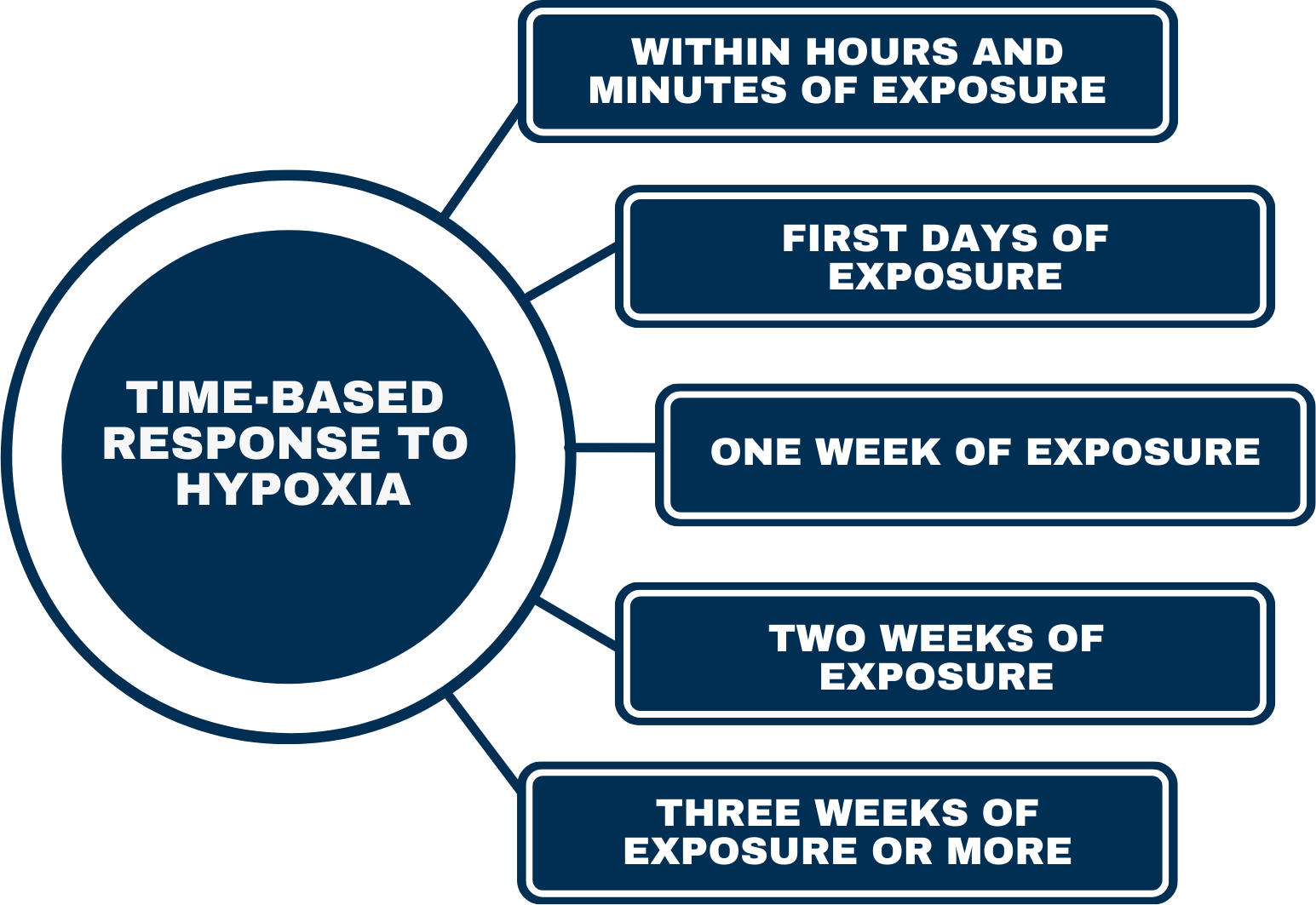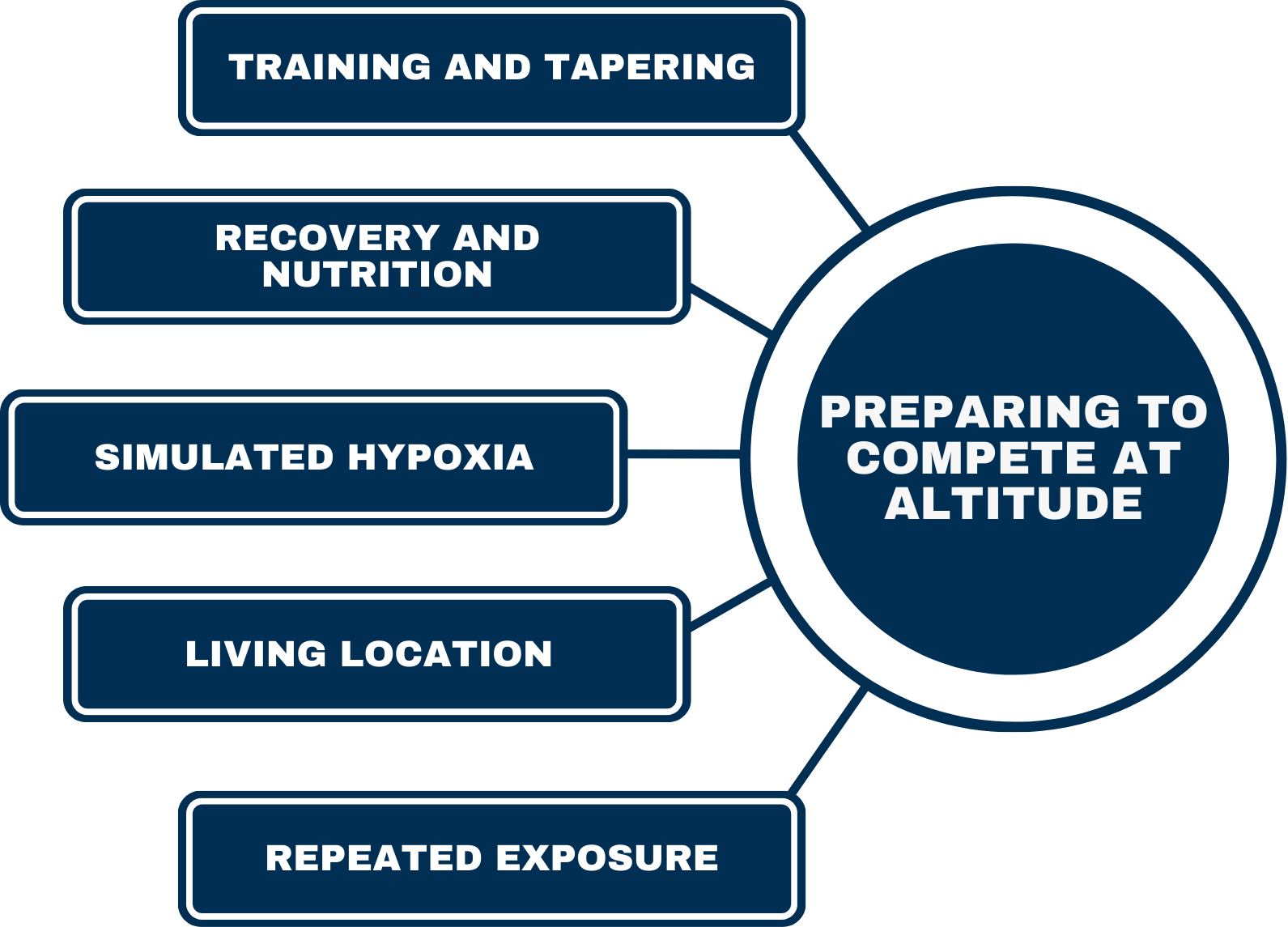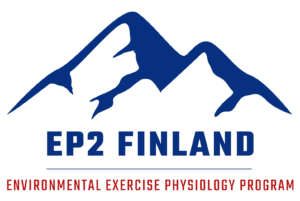Many athletes face the challenge of competing at various altitudes during major events around the globe. For instance, cross-country skiers have participated in World Cup races at altitudes reaching 1800 meters, such as those held in Livigno, Italy. In the realm of mountain running, competitions frequently occur at altitudes exceeding 2000 meters, and the renowned Le Tour de France cycling race features its highest point, Cime de la Bonette, at an elevation of 2802 meters. Furthermore, the extreme conditions of La Paz, Bolivia, at 3600 meters, and Cerro de Pasco, Peru, at 4338 meters, highlight the significant challenges of altitude in team sports. Thus, it is essential for athletes various disciplines to properly prepare for competitions at moderate to high altitudes, as the physiological effects of altitude can significantly influence their performance.
Effects of Altitude on Athletic Performance
Compared to sea level, a gain in altitude creates a hypobaric environment, where decreased barometric pressure leads to a lower air density and a reduced partial pressure of inspired gases, including oxygen (PIO2). This reduction in PIO2 directly impacts oxygen availability, leading to a significant decline in maximal aerobic capacity (V̇O2max). As a result, endurance-based events at altitude can take 10% to 20% longer to complete than comparable races at sea level.1 Maximal oxygen uptake decreases approximately 7% for every 1000 meters of elevation, severely impacting sports like long-distance running and cross-country skiing, which rely on sustained oxygen consumption.2
In contrast, shorter competitions (typically under 1 to 2 minutes) or those requiring high-speed efforts may actually benefit from altitude due to reduced air resistance. For example, in professional cycling, where average race speeds range from 35 to 45 kph, the aerodynamic advantage at altitude can outweigh the reduction in maximal aerobic power, leading to faster race times4.This phenomenon was notably observed during the 1968 Mexico City Olympics held at 2240 meters, where running events saw record-breaking performances in all distances from 100m to 400m.20
Physiological Responses at Altitude
Upon arrival at altitude, the body quickly initiates several responses to counteract the lower oxygen availability. Within the first minutes and hours, arterial oxygen saturation (SaO2) decreases significantly, especially at higher elevations. To offset the drop in SaO2, ventilation and heart rate increase to improve oxygen intake and delivery, though the degree of these changes varies greatly among individuals.6 Additionally, blood lactate concentrations are increased during exercise and perception of intensity and effort are usually higher. Testing and monitoring are essential to understand the individual responses and thresholds in hypoxia.8
During the first days of exposure, fluid loss through increased urination and ventilation leads to a reduction in plasma volume, raising hemoglobin concentration and hematocrit, but not hemoglobin mass (Hbmass) – the blood’s capacity to deliver oxygen. However, these initial days may also bring disruptions in sleep, a higher risk of illness, and a greater chance of dehydration. Given the stress on the body and incomplete adaptation, training volume and intensity should remain low to avoid overexertion before the body adjusts more fully.7
After approximately one week at altitude, the body begins to show initial adaptations, though full acclimatization may require several more weeks, especially at higher elevations, and by the two-week mark, ventilatory adaptation improves oxygen saturation and exercise tolerance, increasing performance in hypoxic conditions.10 After approximately three weeks endurance performance is increased further13 as red blood cell production results in measurable growth in Hbmass, enhancing oxygen transport capacity.14 Extending the exposure even further typically brings additional increases in Hbmass and aerobic capacity. To fully optimize acclimatization and performance, athletes should regularly monitor physiological markers, adapting training, hydration, and recovery strategies according to individual responses. This tailored approach supports gradual, effective adaptation, helping athletes better prepare for high-altitude competition.

To maintain sufficient oxygen levels, several rapid responses occur including an increase in ventilation and an increase in resting and submaximal exercise heart rate. As a result, given exercise pace/power corresponds to a higher relative intensity when compared to values obtained at sea level.
Lactate concentration and heart rate are increased when compared to values during exercise at a similar work rate at sea level. Individual variability is high, however, and there can be a discrepancy between heart rate and lactate thresholds in hypoxia: this means heart rate may not align with lactate responses as it typically would at sea level. Testing in hypoxic conditions is encouraged to reveal the individual response to hypoxia.
Preparing to Compete at Altitude
Arrival
Preparing for the effects of altitude on athletic performance is crucial, with acclimatization recommendations varying widely, from a few hours to several weeks before a competition. When planning for altitude, athletes should consider sport-specific demands, individual physiological responses, and logistical constraints such as time and financial requirements. Optimal acclimatization balances these factors to support both effective adaptation and competitive readiness.
Athletes competing in short-duration, high-velocity sports or in sports with minimal aerobic demands may benefit from a “fly-in, fly-out” approach to minimize the negative effects of hypoxia on training quality, recovery, sleep, nutrition, and hydration. For these athletes, the gains from a prolonged acclimatization period may not sufficiently enhance performance in their sport18, making quick arrival close to the competition time a more viable strategy.
Though time and financial constraints can limit the duration spent at altitude for endurance athletes as well, they should aim for a minimum of 2 weeks of acclimatization prior to key competitions, which can still enhance physical performance at altitude, even if full acclimatization is not feasible.7 Further benefits to oxygen delivery and endurance performance are available from a more prolonged acclimatization.14,15 Normobaric hypoxia can be a viable option for those unable to travel to the competition venue several weeks beforehand. To maximize performance gains, endurance athletes should have multiple exposures to hypoxia throughout the year, which supports progressive adaptation and can lead to a faster acclimatization process. If only a very short time period is available for acclimatization, it may be best to visit the competition location the day before but to sleep at a low altitude and return to high altitude on the day of the competition.7
Training and Tapering Strategies for Altitude
Endurance athletes should follow a phase-approach to optimize their performance when training at altitude. Before traveling, reduce training load at sea level for 4–6 days. Upon arrival, limit intensity and volume for the first week to allow acclimatization, and gradually increase training load, incorporating race-pace segments in the following 7–10 days. Taper with low to moderate intensity during the last 4–6 days before competition.21 For altitudes above 2500 meters, emphasize training volume while keeping intensity low.1,6 Use tools like RPE, heart rate, SaO₂, and lactate to adjust intensity and monitor acclimatization.14
Recovery, Nutrition, and Living at Altitude
Altitude increases physiological demands, requiring greater focus on recovery and nutrition. Athletes should prioritize iron intake and supplementation to support hemoglobin production, increase energy, carbohydrate, and fluid intake, and increase antioxidant intake from food sources avoiding high-dose antioxidant supplements.7
Yearly training plans should integrate altitude camps to monitor physiological responses and to improve acclimatization strategies.7 For endurance athletes, repeated or permanent altitude exposure is beneficial for enhancing performance at altitude (and at sea level) and can lead to faster acclimatization, but if long stays are not possible, incorporating simulated and intermittent hypoxia may be a viable option. These approaches help determine individual adaptation timelines and minimize future onsite preparation needs.7 During competition preparation spend time at altitudes close to the competition altitude but not necessarily at the competition venue. Lower altitudes may not provide sufficient stimulus for adaptation and higher altitudes may risk overtraining and maladaptation13 while limiting time spent at the competition venue may reduce unnecessary psychological stress and provide a better training environment.7

Preparation: decrease training load at sea level 4 to 6 days in advance of travelling to altitude.
Acclimatization: Keep training load (intensity and volume) low during the first 4 to 7 days at altitude to ensure initial acclimatization
Activation and stabilization: Increase training load and include high intensity workouts, with segments at racing pace, during a 7–10-day period preceding the final taper
Taper: Use low to moderate training load during the last 4-6 days before competing at altitude If the competition is above 2500 meters, further emphasis should be placed on training volume, keeping intensity low.
Adjust exercise intensity based on subjective and objective measures such as RPE, heart rate, SaO2, and lactate.
Monitoring key variables and performance at altitude is the best way to determine individualized response to hypoxia. Individual response can be utilized to increase knowledge on pacing, hydration, nutrition, and recovery/sleep when at altitude which will be helpful for future competitions.
Increase iron intake to enable a positive hemoglobin response. Supplementation is encouraged.
Increase energy, carbohydrate, and fluid intake at altitude.
Ensure sufficient intake of antioxidants from food sources and avoid high-dose supplements.
Response rates are highly individual, and support teams should utilize simulated and intermittent hypoxia to determine the individual time courses of various hypoxic exposures to reduce future onsite preparation periods and determine what minimal dose provides meaningful gains.
If an athlete is aiming to increase Hbmass, the optimal living altitude is 2000-2500 m and altitudes lower than 1800 m do not appear to provide sufficient hypoxic stimulus for key physiological adaptations.
Be aware that altitudes exceeding 2500 m are more likely to cause overtraining and to compromise the ability of an athlete to absorb and respond to hypoxia and training stimuli.
Living permanently at altitude is beneficial for endurance performance at altitude. Many athletes are unable to permanently move to a higher altitude and therefore implement altitude training camps into yearly training plans and especially in the preceding weeks before a competition at altitude.
Coaches recommend conducting training camps at the same altitude but in different locations than the competition site to reduce stress and optimize training. Additionally, use these training camp settings to test, monitor and determine individual acclimatization patterns.
Repeated hypoxic exposures help facilitate faster acclimatization. This is largely due to repeated exposures eliciting a hypoxic memory in erythrocytes (red blood cells) which stimulates a greater release of adenosine, a potent vasodilator that increases oxygen delivery to the tissues.
Repeated hypoxic exposures provide a reoccurring stimulus for Hbmass increases and additional non-hematological training adaptations that are not affected by sea-level training.
A good travel plan, adjustments to training load, and knowledge regarding an individual response during a prior hypoxic exposure will enable an athlete to feel confident competing at low, moderate, and high altitude. EP2 FINLAND brings the aid and assistance of field experts to your disposal. Utilizing these resources together with effective monitoring and proper planning will provide a clear path to follow and aid in performance success.

References:
- Saunders, P. U. et al., (2009). Endurance training at altitude. High Altitude Medicine & Biology, 10(2), 135-148.
- Wehrlin, J.P., Hallén, J. (2006). Linear decrease in VO2max and performance with increasing altitude in endurance athletes. Eur J Appl Physiol, 96, 404–412.
- Lippi G. et al., (2014). Mean speed in professional cycling: no evidence of decline. Perform Enhanc Heal, 3(1), 45–48.
- Hahn, A.G., Gore, C.J. (2001). The Effect of Altitude on Cycling Performance. Sports Medicine, 31, 533–557.
- Bergeron, M. et al., (2012). International Olympic Committee consensus statement on thermoregulatory and altitude challenges for high-level athletes. British Journal of Sports Medicine, 46(11), 770–779.
- Treff G. et al., (2022). Hypoxic training in natural and artificial altitude. Dtsch Z Sportmed. 73, 112-117.
- Burtscher, M. et al., (2018). Preparation for Endurance Competitions at Altitude: Physiological, Psychological, Dietary and Coaching Aspects. A Narrative Review. Frontiers in Physiology, 9, 1504.
- Friedmann, B. et al., (2005). Individual Variation in the Reduction of Heart Rate and Performance at Lactate Thresholds in Acute Normobaric Hypoxia. International Journal of Sports Medicine, 26(7), 531–536
- Chapman, R. F. et al., (2013). Timing of Arrival and Pre-acclimatization Strategies for the Endurance Athlete Competing at Moderate to High Altitudes. High Altitude Medicine & Biology, 14(4), 319–324.
- Townsend, N. E. et al., (2016). Ventilatory acclimatisation is beneficial for high-intensity exercise at altitude in elite cyclists. Eur. J. Sport Sci. 16, 895–902.
- Schuler, B. et al., (2007). Timing the arrival at 2340 m altitude for aerobic performance. Scand J Med Sci Sports.17:588–594.
- Nummela, Ari, et al. (2021). Variability in hemoglobin mass response to altitude training camps. Scandinavian Journal of Medicine & Science in Sports, 31(1), 44-51.
- Chapman, Robert F., et al. (2016). Living altitude influences endurance exercise performance change over time at altitude. Journal of Applied Physiology, 120(10), 1151-1158.
- Girard et al., (2023). “Living High-Training Low” for Olympic Medal Performance: What Have We Learned 25 Years After Implementation? International Journal of Sports Physiology and Performance, 18(6), 563-572.
- Clark, S.A., et al. (2009). Time course of haemoglobin mass during 21 days live high:train low simulated altitude. Eur J Appl Physiol 106, 399–406.
- Mujika, I. et al., (2019). Contemporary Periodization of Altitude Training for Elite Endurance Athletes: A Narrative Review. Sports Medicine, 49, 1651–1669
- Sandbakk, Ø. et al., (2021). Preparing for the Nordic Skiing Events at the Beijing Olympics in 2022: Evidence-Based Recommendations and Unanswered Questions. Journal of Science in Sport and Exercise, 3(3), 257–269.
- Fulco C.S. et al., (1998) Maximal and submaximal exercise performance at altitude. Aviat Space Environ Med. 69(8), 793-801.
- Nassis, George P. (2013). Effect of Altitude on Football Performance: Analysis of the 2010 FIFA World Cup Data. Journal of Strength and Conditioning Research. 27(3), 703-707.
- https://olympics.com/en/olympic-games/mexico-city-1968/results
- Wilber RL (2003) Altitude Training and Athletic Performance.
- Grassi, B., Marzorati, M., Kayser, B., Bordini, M., Colombini, A., Conti, M., … Cerretelli, P. (1996). Peak blood lactate and blood lactate vs. workload during acclimatization to 5,050 m and in deacclimatization. Journal of Applied Physiology, 80 (2), 685—692.
- Rusko, H., Tikkanen, H., & Peltonen, J. (2004). Altitude and endurance training. Journal of Sports Sciences, 22(10), 928–945.
Authors:
Christina Kuorelahti, PhD;
Jere Borgenström, MSc;
Dominique Gagnon, PhD, Adjunct Professor;
Juha Peltonen, PhD, Adjunct Professor
